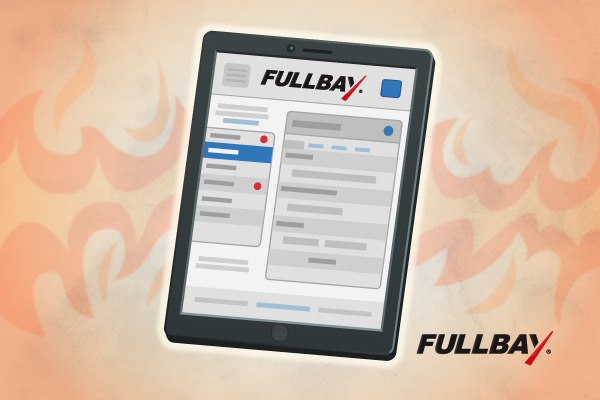8 Hottest Features of Fullbay You Should be Using

Working in heavy duty repair, you understand the value using the right tool for the job. You wouldn’t send a tech out with a screwdriver to change a tire. When you have Fullbay software, you get loads of features that improve efficiency, save time, and help manage inventory to make your shop more profitable. We could write a book on all the useful elements Fullbay puts at your fingertips. However, here are eight of Fullbay’s hottest features heavy duty shops should be using every day.
1. Customer Portal
Communication is key in any relationship but it can eat up time. Phones ringing are usually a good thing because it means business is coming in. However, someone needs to answer those phones and spend time talking to customers. Among Fullbay’s hottest features is a customer portal that keeps you in contact with customers while cutting down on time spent communicating.
How many calls per day do you field dealing with service requests, questions about repair progress, and inquiries about service history? The majority of those interruptions to your day go away with the Fullbay customer portal. Not only does it allow customers to access all that information themselves, but it also lets them see estimates, invoice copies, and allows them to pay you with the click of a button. The portal even displays tech comments on active services. However, you can choose whether to share techs’ notes in real time or hide them until invoicing, allowing you to retain ultimate control over what customers see.
You can get everyone on the customer portal starting with a few customers at a time. Get the customers who are tech-savvy or who need a lot of hand-holding onto it first. Help them download it onto their smartphone or tablet—your shop’s logo will be the icon for the Fullbay app—and add it to their homescreen. It’s extremely user-friendly and intuitive, but you can walk them through a few sample service requests and show them how to access their trucks’ histories to get them started.
2. Vendor Portal
Vendors have a voice, too, and communication with them is no less time-consuming than talking to customers. That’s why one of Fullbay’s hottest features is a vendor portal. The great thing about this particular portal is that it saves both you and vendors time. They’re bombarded with phone calls all day long, taking orders, giving price quotes, and answering other questions. The Fullbay vendor portal frees sends pricing quote requests and orders via email, freeing you both from the phone.
The email includes all the vital information for accurately filling your request. For instance, for a parts quote, the vendor will see what parts you need, but also the data on the specific truck you need them for, including the year, make, model, VIN, and engine serial number. He just fills in the part numbers, prices, and delivery ETA then submits it back to you. What’s more, when the quote gets back to you, Fullbay will have already applied the markup. All you have to do is move the info into your estimate.
It’s even easier to get vendors started using Fullbay as it is introducing it to customers. Just tell them you have Fullbay software and are using it to submit orders and request quotes. You can also let them know that they’ll be able to view payment summaries so they can see invoice statuses at a glance. Plus, vendors can learn to use the portal in less than 5 minutes thanks to the 60-second training videos available on the Fullbay site.
3. ROI Calculator
Financial and accounting specialists rely on ROI calculations to measure the performance and efficiency of a business. They go deep, delving into limitations and developments of ROI but as a shop owner or manager, you want to keep it simple. You just want to make your shop as profitable as possible. With Fullbay’s hottest features, you don’t need an MBA to make that happen. Just fill in the numbers that apply to your shop, such as the labor rate you charge, the rate you pay your techs, how many hours per week each tech works, and how many hours per week you bill. Fullbay’s ROI tool also asks for info on other issues like your management/office staff, parts and supplies costs, and overhead.
Using that data, the tool figures how well your techs are performing and how profitable the business is. Ideally, your shop’s costs and profit should be divided like this:
- 25 percent to purchasing parts
- 20 percent to paying tech labor
- 8 percent to paying office staff
- 22 percent to other overhead
- 5 percent to savings
That would leave your shop with a 20 percent profit. If the ROI calculator shows that you’re not meeting that profit level, you can play around with the numbers to see what changes you need to make to create the profitability you want.
4. Price Matrix
If you’re using a flat scale to markup parts, you’re hurting your business. You need different price scales for different parts and different vendors, but also for different customers. Different pricing markups give you room to negotiate discounts for different situations. For example, you could offer lower prices customers who give you all their business or let you track PM’s and still make a profit.
Having several pricing scales can get confusing. That’s why most shops have one guy who is a pricing whiz. He’s the one who usually works weekends trying to stay on top of pricing out new vendor lists. And, if he ever goes on vacation, you might as well close down the shop, because he’ll take his expertise with him. Price scales are one of Fullbay’s hottest features that simplifies markup for everyone.
Price scales in the price matrix are the recipe for your shop’s magic matrix, allowing you to set customer levels, parts categories, and vendors. Inside the scale, you can set decreasing markup percentages with corresponding graduating wholesale prices. Plus, you can create exception rules that give different pricing to specific vendors and parts, and you can dictate which type of sale (counter sale or job use) applies to different matrices. For multiple shop operations, Fullbay even allows you to create different matrices for different shops. They’re easy to build and the software applies them automatically. That means you’ll no longer need calculators and spreadsheets for figuring markups.
5. Price Sheets from Your Vendor
Since your business runs on labor and inventory, more than one of Fullbay’s hottest features deals with parts pricing. The vendor price sheets feature stores entire vendor catalogs, giving you access to prices for non-inventory parts with the click of a button. This feature is ultra-efficient, with the ability to upload up to 15,000 parts at a time from vendors.
Plus, you can import price sheets as vendors update them. The price sheets inside Fullbay allow you to make special orders using catalog parts on service orders. It also lets you manage sheets by dates, price, and vendor. And, when you place inventory orders using catalog parts from your price sheets, the system automatically converts the order into stock, making inventory easier.
6. Special Order Counter Sales
Fullbay’s hottest features make selling parts on demand a snap—even non-inventory parts. The software incorporates your pricing scales with vendor catalog info and the rules you set to automatically set prices based on customer or shop settings. When you place a special order for a non-inventory item, you can link it to a counter sale in Fullbay. There’s also an “unlink” feature to order inventory parts from a counter sale. You can even consolidate counter sales with existing orders to expedite delivery or help your parts manager meet a vendor threshold for ordering. Plus, there’s a privacy feature that allows you to share or hide markups with customers, too.
7. One of Fullbay’s Hottest Features Helps Manage PM’s
If you’re not managing customer PMs today, you have to start. It will boost your shop’s revenue immediately, and one of Fullbay’s hottest features will help you manage the whole thing. It keeps a history on every vehicle you track so you not only know when maintenance is needed next but also what parts and products were used in past services, too. This feature also keeps track of recommended repairs. What’s more, you can set the service schedule according to time, miles driven, or customer preference.
Fullbay makes it easy to access all that info, too. The fleet report shows you all the stats on entire fleets as well as allowing you to drill down to individual units. You can even run a report that shows the fleet cost per unit. Plus, customers can view the fleet report through their portal. That lets them see when trucks are coming due for work, whether it’s a regular PM or a scheduled global service.
8. Lone Wolf Techs
Lone wolf techs are the masters of mobile service. With low overhead, it’s highly profitable and customers love it. Fullbay’s hottest features are the perfect solution for lone wolf techs because it automates all of the support a heavy duty mechanic typically gets from shop staff.
With Fullbay, mobile techs self-assign jobs and can process orders in the field, including no-delay invoicing. That’s possible because of the real-time parts markup and vendor billings that Fullbay takes care of behind the scenes. Fullbay’s inventory features help lone wolf techs keep service truck stock up-to-date and out of negative status. Plus, it increases mobile tech productivity. Fleets can request a mobile tech to come take care of PM’s on-site, which is not only efficient but provides the opportunity to upsell, recommending maintenance and repairs for safety purposes. That’s not only good for your business, but it gives fleets better uptime and more of it.
It’s easy to experience Fullbay’s hottest features for yourself—just fill in the form below!

